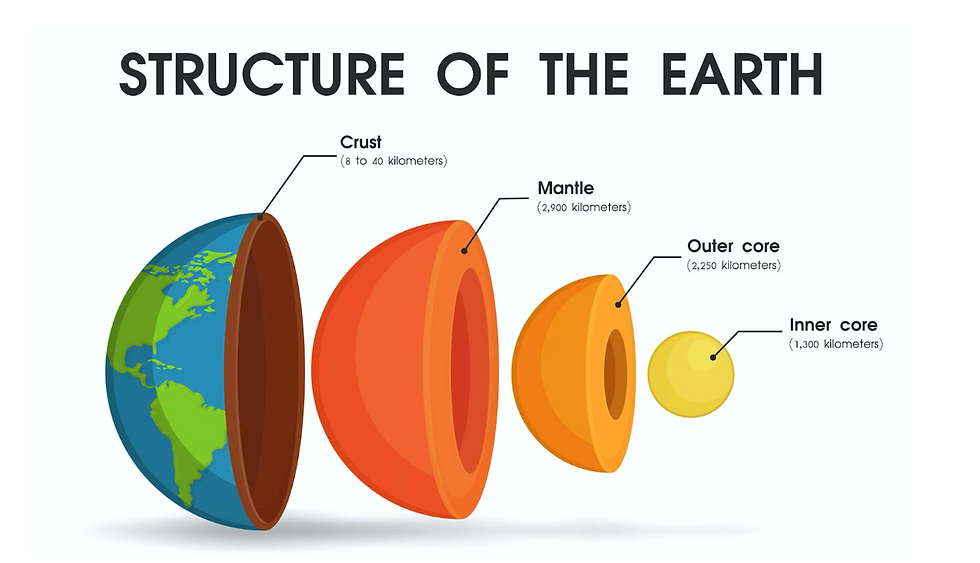Layers of the Earth Explained - A Simple Guide
- innovatewithstem12
- Jan 8
- 2 min read
Updated: Feb 15
Published on: January 7th 2025
To understand the key workings of the Earth and its structure, we must understand its four main layers: the crust, the mantle, the outer core, and the inner core.

The Crust
The crust is known as the Earth’s outermost layer. It is thin compared to the other layers and is divided into two main types: oceanic and continental. The oceanic crust is mainly composed of basalt (fine-grain igneous volcanic rock), while the continental crust is less dense, thicker, and composed of granite. The Earth’s crust layer is cold and brittle compared to the other layers.
The Mantle
Underneath the thinnest layer, the crust lies the mantle, which expands almost 3,000 kilometers. This layer is composed of minerals that are rich in magnesium and iron. The mantle is divided similarly to the crust; however, upper and lower regions separate it rather than how the oceanic regions divide the crust. The upper part of the mantle comes together with the crust to form the lithosphere. The mantle is hot and semi-solid (think caramel!).

Outer Core
The outer core resides 5,000-3000 kilometers beneath the surface. This part of the Earth’s core is made from iron and nickel in liquid form. Due to radioactive decay from the elements uranium and thorium, the liquid form of iron and nickel move in unpredictable and chaotic currents. These motions generate electrical currents and develop the Earth’s magnetic field.
Inner Core
The Earth’s inner core layer has a radius of about 1,200+ kilometers and is located 6500+ kilometers beneath the surface. Similar to the outer core, It is mostly made of iron and nickel, but not in liquid form, making it extremely dense. The inner core tends to spin faster than the rest of Earth. The temperature here is approximately 5,400 degrees Celsius.
The Earth's crust, mantle, outer core, and inner core shape the Earth and sustain life. Every layer plays an important role from, where we live, to the core, which creates the Earth's magnetic field.
Works Cited
California Academy of Sciences. “From Core to Crust: Defining Earth’s Layers.” California Academy of Sciences, 2020, www.calacademy.org/explore-science/from-core-to-crust-defining-earths-layers.
EarthHow. “Inside Earth: The Crust, Mantle and Core.” Earth How, 25 July 2017, earthhow.com/inside-earth-crust-core-mantle/.
geiger, beth. “Explainer: Earth — Layer by Layer.” Science News Explores, 11 Nov. 2019, www.snexplores.org/article/explainer-earth-layer-layer.
Geological Survey Ireland. “The Earth’s Structure.” Www.gsi.ie, 2019, www.gsi.ie/en-ie/education/our-planet-earth/Pages/The-Earth-structure.aspx.
Sharp, Tim. “What Is Earth Made Of?” Space.com, Space, 14 Nov. 2017, www.space.com/17777-what-is-earth-made-of.html.
“Structure of the Earth! | National Geographic Kids.” National Geographic Kids, 7 Nov. 2018, www.natgeokids.com/uk/discover/geography/physical-geography/structure-of-the-earth/.





Comments